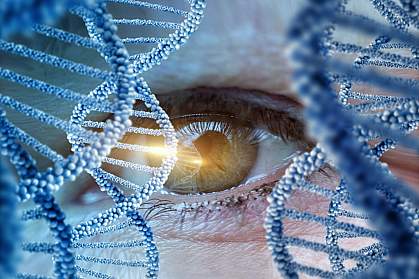You are here
November 3, 2020
Gene therapy with novel protein restores vision in mice
At a Glance
- Researchers restored vision in blind mice by using gene therapy to add a novel light-sensing protein to cells in the retina.
- The therapy will be tested in people later this year.

Several common eye diseases damage the retina, the light-sensitive tissue in the back of the eye. Cells in the retina called photoreceptors convert light into signals sent to the brain. Age-related macular degeneration and retinitis pigmentosa are among the diseases that damage photoreceptors, leading to vision loss.
There is no cure for these diseases. Interventions have been aimed at slowing retinal degeneration. Implantable devices called retinal prostheses can restore limited vision for some. However, these “bionic eyes” require invasive surgery, wearable hardware, and provide only low-resolution images. Gene therapies have been promising, but these approaches largely require photoreceptors to remain intact.
Researchers have been developing gene therapy approaches that bypass damaged photoreceptors to restore sight. They use a harmless virus to deliver a gene that allows remaining retinal cells to produce a protein enabling them to sense light.
Current treatments use light-sensitive proteins called opsins, which are normally made by the rod and cone photoreceptors in the retina. But opsin replacement strategies in development require intense light to reach the threshold needed to create a signal to send to the brain. This requires goggles to boost the natural or ambient light. Shining intense light into the eye risks further damage to the retina.
A research team led by Dr. Samarendra Mohanty of Nanoscope Technologies set out to engineer an opsin that could be activated with lower levels of light. Their work was funded by NIH’s National Eye Institute (NEI). Results were published in Nature Gene Therapy on October 22, 2020.
The team started by modeling and synthesizing a gene that would produce a more photosensitive form of opsin. The MCO1 opsin gene was then tested in mice that were completely blind from retinal degeneration. The gene was added to a harmless virus and injected into the eye. There, the virus delivered the gene to bipolar cells, which normally relay the signals from rod and cone cells. These cells are still functional even when the photoreceptors no longer work.
The therapy restored retinal function and vision to the blind mice. Treated mice were significantly faster in standardized visual tests, such as navigating mazes and detecting changes in motion. The researchers found no concerning safety issues in the treated mice, with no signs of inflammation in blood and tissues.
This therapy offers promise for a wide range of degenerative retinal diseases. It requires a one-time injection into the eye and eliminates the need for wearable hardware. MCO1 is sensitive to ambient light, so there is no need for strong light to be shined into the eyes. Researchers are planning to start tests in humans by the end of the year.
“A clinical study in people will help us understand how signaling through bipolar cells affects vision quality; for example, how well treated eyes can pick out fast-moving objects,” says first author Dr. Subrata Batabyal of Nanoscope Technologies.
Related Links
- Lab-made Eye Cells Restore Vision in Mice
- Regenerating Light-Sensing Eye Cells in Mice
- Genetic Engineering Prevents Retinal Cell Loss in Mice
- Novel Gene-Editing Method Improves Vision in Blind Rats
- Long-Term Benefits of Age-Related Macular Degeneration Treatments
- Gene Therapy for Eye Disease Shows Benefits and Limitations
- Improving Gene Therapy for Eye Diseases
- Retinal Device Restores Sight in Mice
- Age-Related Macular Degeneration
- Retinitis Pigmentosa
References: Sensitization of ON-bipolar cells with ambient light activatable multi-characteristic opsin rescues vision in mice. Batabyal S, Gajjeraman S, Pradhan S, Bhattacharya S, Wright W, Mohanty S. Gene Ther. 2020 Oct 22. doi: 10.1038/s41434-020-00200-2. Online ahead of print. PMID: 33087861.
Funding: NIH’s National Eye Institute (NEI).
